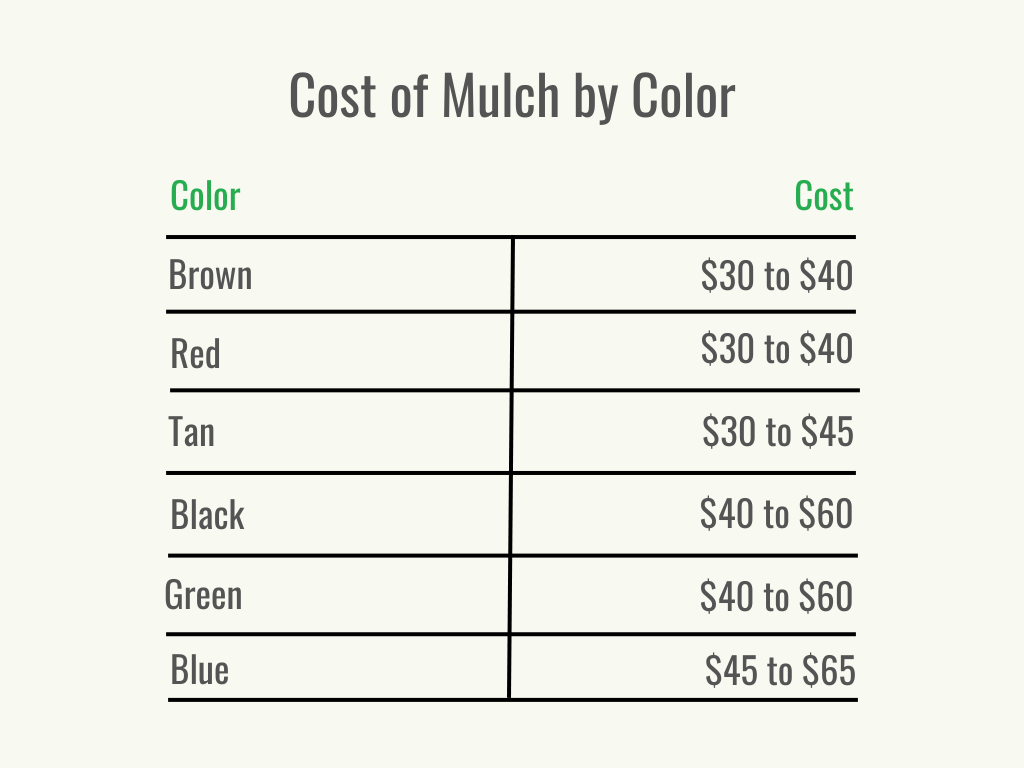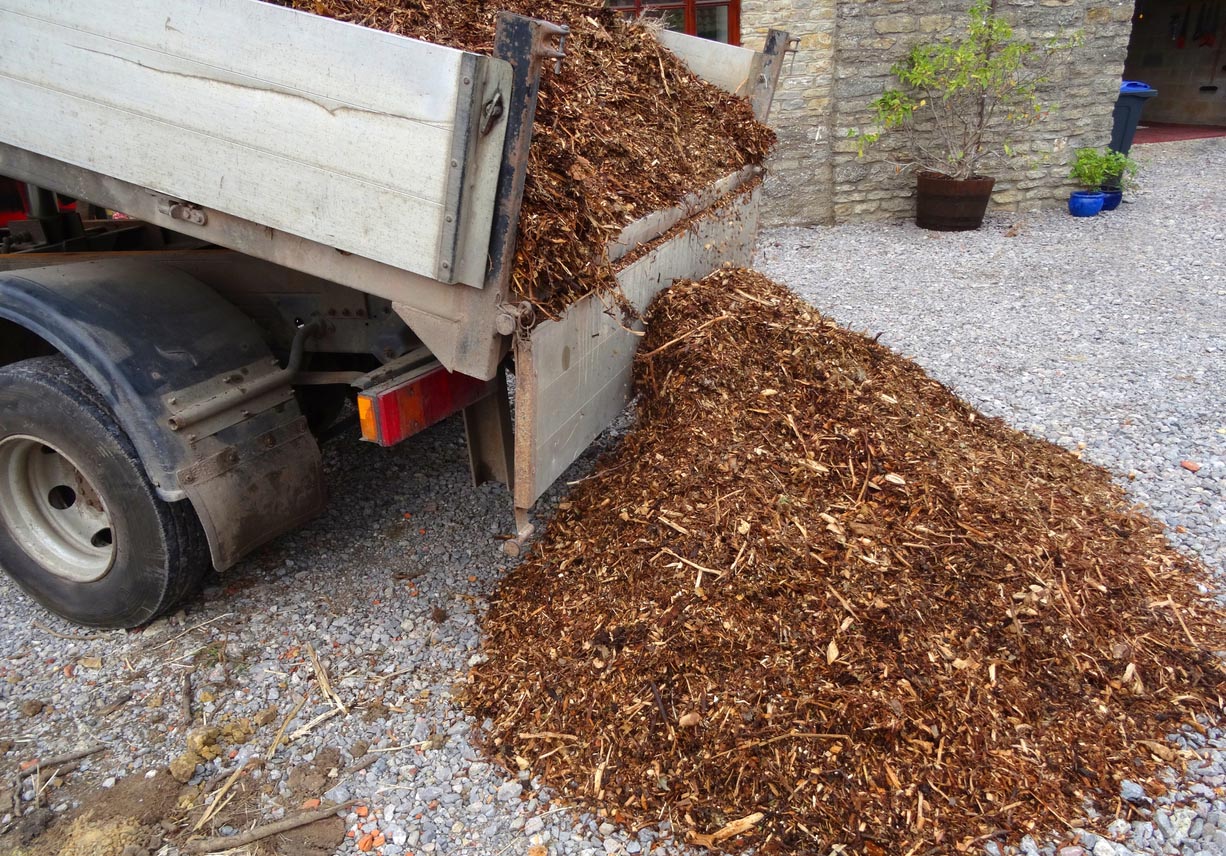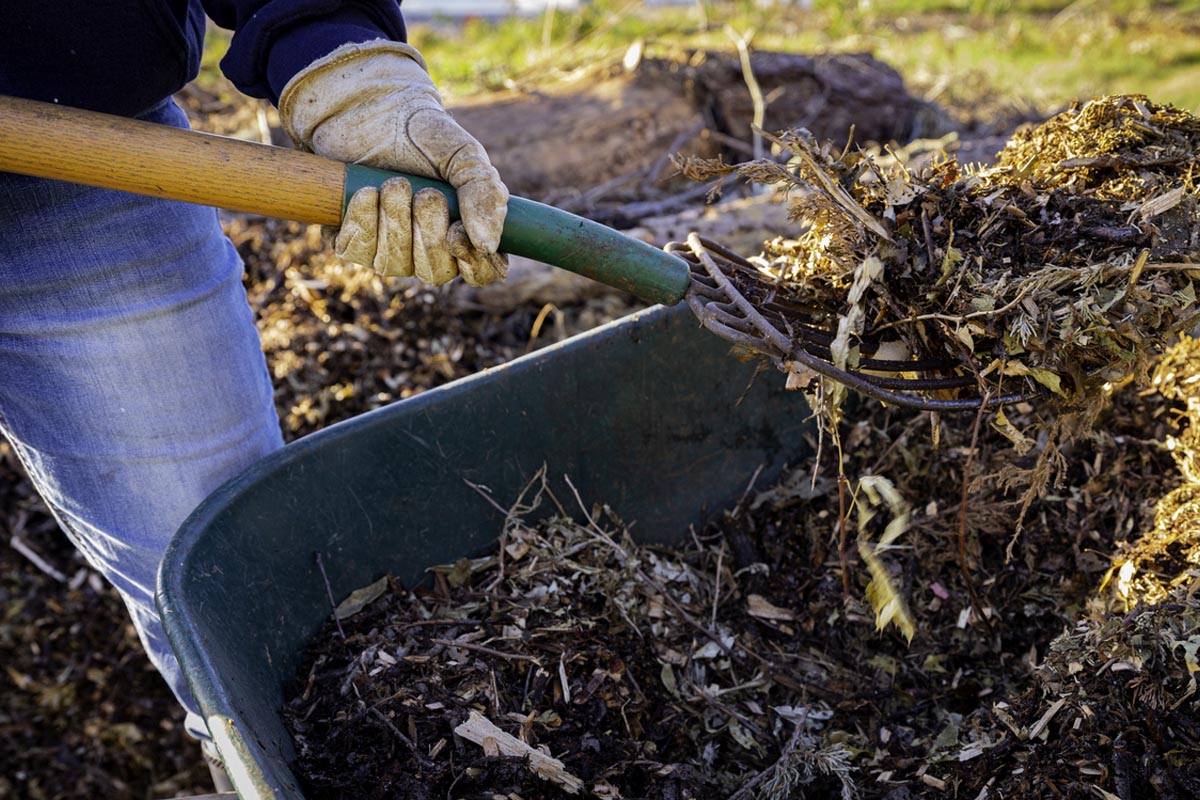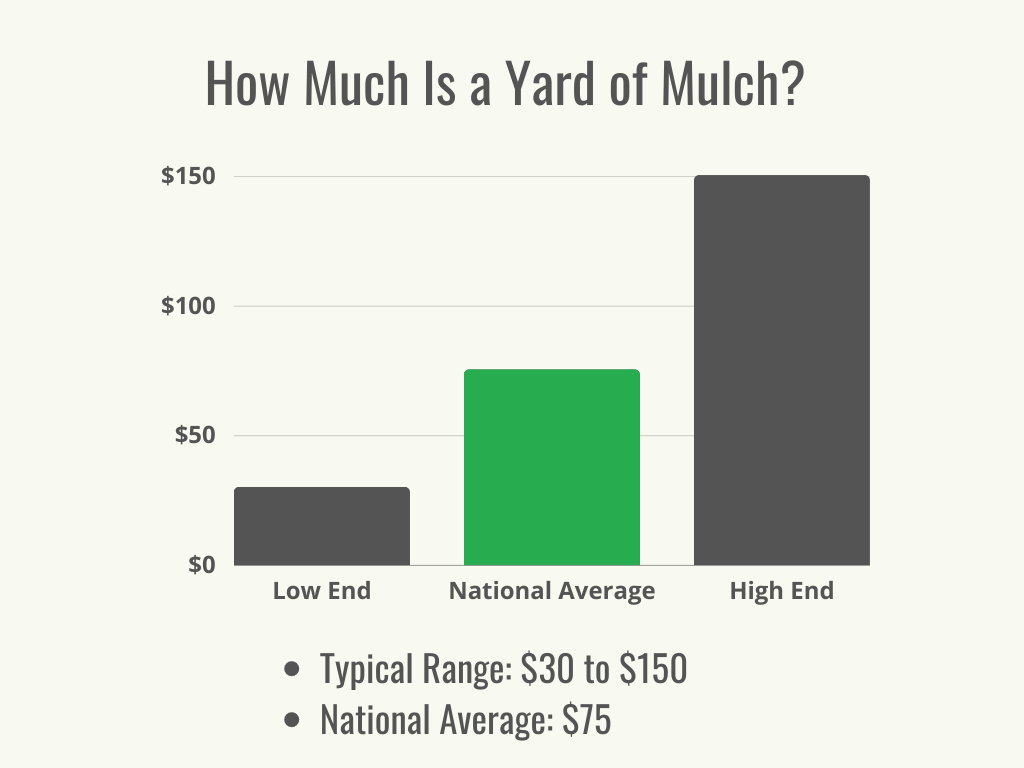We may earn revenue from the products available on this page and participate in affiliate programs. Learn More ›
Highlights
- The typical cost of mulch per yard is between $30 and $150, with a national average of $75.
- Factors affecting the cost of mulch include the mulch type and color, project size, choice between organic and inorganic mulch, delivery, labor, and installation.
- Installing mulch in a yard can reduce evaporation, prevent weed growth, improve soil insulation and quality, and enhance a yard’s aesthetics.
- Most enthusiastic gardeners can install their own mulch if they so choose; however, it may be wise to have a landscaper recommend the appropriate type and amount of mulch for the yard.
Mulch offers a finishing touch for flower beds, perennial beds, and gardens, and purchasing it in bulk (by the cubic yard) is the most cost-effective way to buy it. So how much does mulch cost? According to Angi and HomeAdvisor, a yard of mulch ranges in cost from $30 to $150 with a national average cost of $75 per yard. Numerous factors can affect the final cost, including the type of mulch purchased. Included below are details about this product and how it reduces weed growth, helps soil retain moisture, keeps plant roots cool in scorching temperatures, and makes a yard look attractive.
How to Calculate How Much Mulch You Need
How much will a yard of mulch cover, and what exactly is a yard of mulch? When someone says “a yard of mulch,” what they’re actually referring to is a cubic yard. So how much is a cubic yard of mulch? It’s equal to 3 feet by 3 feet by 3 feet (27 cubic feet) of mulch. Homeowners can use the following formula or a mulch installation cost calculator to determine how much mulch is needed for a specific area:
- Measure the width of the area.
- Multiply that number by the length of the area.
- Multiply that number by the desired depth of mulch in inches (3 inches is about average).
- Divide that number by 324 for the amount in cubic yards.
For example, if a perennial bed measures 20 feet long and is 10 feet wide, multiply 20 by 10, which comes out to 200 square feet. To cover the bed with 3 inches of mulch, multiply 200 by 3 (200 x 3 = 600). Then divide 600 by 324 to arrive at 1.85 cubic yards. For the best results, it’s a good idea to round up to the nearest ¼ of a yard, so the gardener or landscaper would want to order 2 cubic yards.
Factors in Calculating Cost
Buying mulch by the cubic yard is the most cost-effective method. A single yard of mulch (material only, not including delivery or installation) runs about $30 to $150 or an average of $75. Companies may not give a discount for buying just a few yards, so 3 yards might run $90 to $450, and 10 yards might run $300 to $1,500. A purchase of 20 yards or more, however, might result in a slight discount. For example, if a customer buys a whole truckload that carries 20 yards, they could pay $550 for the entire load, which averages about $27.50 per yard. Additional factors that affect mulch cost include the type of mulch, whether it’s organic, and delivery and installation costs.
Mulch Type
The cost of mulch varies widely by type. The more plentiful the mulch, the less it typically costs. Pine bark, for example, is a common type of mulch, and it runs about $30 per cubic yard, while red mulch and black mulch (usually pine mulch that’s been dyed) run about $35 and $40 per cubic yard, respectively. Hardwood mulch sells for around $40 a cubic yard, while cypress, which is in lower supply but naturally repels insects, can run around $110 per cubic yard.
Mulch Color
While many types of mulch come in a natural shade of brown or black, there are some dyed varieties on the market. These can lend an attractive and visually interesting look to the yard, but they typically cost extra. Some common colors are blue, green, red, tan, and black. Brown, tan, and red mulch ranges from $30 to $45, but black, green, and blue mulch can cost $40 to $65. Some of these types of mulch may contain rubber instead of or in addition to organic materials. For example, the best black mulch can be made from wood, rubber, or a combination.

Project Size
The larger the area to be landscaped, the more it will cost. Skimping on mulch to save money could have undesirable results, especially if the mulch layer is too thin to stop weed growth adequately. Buying the mulch in bulk will often result in a discounted rate. For example, if 1 yard costs $45 to $130, 5 yards of mulch costs $175 to $600. On average, 3 inches of mulch is necessary to block weeds and reduce moisture evaporation from the soil, but some prefer a thicker layer (up to 6 inches). Below are some average mulch costs per yard based on project size.
| Project Size by Cubic Yard | Mulch Cost per Cubic Yard | Total Project Cost |
| 1 | $45 to $130 | $45 to $130 |
| 2 | $45 to $130 | $90 to $260 |
| 3 | $45 to $130 | $135 to $390 |
| 4 | $35 to $120 | $140 to $480 |
| 5 | $35 to $120 | $175 to $600 |
| 6 | $25 to $110 | $150 to $660 |
Organic vs. Inorganic Mulch
Organic mulch is made from natural ingredients and does not contain chemicals, artificial colors, or any other components that might leech into the soil, making it well suited for vegetable gardens. Organic wood chips run an average of $30 to $150 per yard. On the flip side, inorganic mulches, such as recycled rubber chips, can run between $20 and $400 per yard. The table below breaks out organic mulches and inorganic mulches.
Delivery
A truck with a dump bed will typically deliver large amounts of mulch. Mulch is loaded onto the truck in the materials yard of a landscape company, or the company may purchase the mulch directly from a supplier. Either way, a front-end loader is required for loading the mulch into the dump bed, and then the truck can deliver and dump the mulch. Due to the overhead costs of purchasing and maintaining the heavy equipment, homeowners can expect mulch delivery costs for a truckload of mulch to start around $160 per load. If multiple truckloads are ordered, the cost per load may be as low as $120.
Labor and Installation
Mulch installation costs $0.20 per square foot. This cost can be eliminated by homeowners learning how to mulch flower beds and perennial borders; however, not everyone has the time or the physical capability to do this project. The cost of mulch installed in an area of 500 square feet will run about $300 to $400. For those who live outside the area typically serviced by the landscaping company, a travel fee may be added to the cost of labor and installation.

Additional Costs and Considerations
Installing mulch is pretty much a straightforward chore, but it comes with a few variations, such as having it blown on rather than spread with a rake, and it may require the installation of sheets of mulch placed beneath standard mulch chips or shreds. These variations can affect the overall cost of the project.
Mulch Blowing
Shredded wood chips can be applied to landscaped perennial beds and large areas using a blowing machine. Blowing reduces the amount of labor required to spread out the chips, and most homeowners will pay between $35 and $60 per cubic yard, or $50 per cubic yard on average, to blow on mulch. The cost will also vary depending on the type of wood chips chosen.
Mulching Sheets
In some situations, a mulching sheet made from woven cloth or plastic is beneficial for use as an additional weed-blocking layer between the soil and the mulch layer. A woven or perforated sheet will allow water to filter through but block weed seeds from sprouting. Homeowners can expect to pay about $0.20 to $0.65 per square foot for mulching sheets or landscaping fabric, with plastic sheeting being the least costly option.
Additional Landscaping Services
Mulching the garden can make it look neat and polished. To further enhance the yard’s appearance, many homeowners choose to pay additional landscaping costs for services like weeding, grading, and edging at the same time. While mulching can effectively prevent weed growth, any weeds that are already present before the mulch is applied will need to be removed, which costs $65 to $170 when done by a professional. Grading is the process of leveling any uneven parts of the lawn and costs $800 to $4,000. Installing mulch on a graded yard will give it a neater look. Lastly, edging mulched parts of the yard with stones, metal, or plastic looks tidy and prevents mulch from spilling onto the lawn. Depending on the material, edging can cost $5 to $13 per linear foot.
How Much Is a Yard of Mulch by Type of Mulch?
Homeowners are often surprised by the multiple types of mulch available at a range of costs. Wood that is in greater demand or harder to source typically results in mulch that’s more expensive, while recycled wood from pallets can be much more affordable. Before shopping for mulch, it’s a good idea for a homeowner to settle on a budget and then choose from the types available in that price range. The different types of mulch and their costs per cubic yard are detailed below.
| Mulch Type | Cost per Cubic Yard |
| Bark mulch | $95 |
| Black mulch | $40 |
| Cedar mulch | $100 |
| Cypress mulch | $110 |
| Hemlock mulch | $45 |
| Pine bark | $30 |
| Pine needles | $150 |
| Red mulch | $35 |
| Redwood mulch | $60 |
| Rubber mulch | $120 |
| Shredded hardwood mulch | $40 |
| Straw mulch | $35 |
| Wood chips | $24 |
Bark Mulch
True to its name, bark mulch is sourced from trees harvested for other purposes, such as making lumber. Some prefer bark mulch because a tree’s natural bark texture shows through, adding another design element to the landscape. However, this upgrade comes at a higher price as bark mulch runs about $95 per cubic yard.
Black Mulch
While black mulch is also a dyed mulch, it’s typically dyed with either a carbon-based or iron oxide-based chemical and is slightly pricier at about $40 per cubic yard. Black mulch also comes in rubber chips, which are well suited for playgrounds under equipment because they provide a soft surface for children playing. Black rubber mulch runs about $120 per cubic yard.
Cedar Mulch
Cedar mulch is prized for its aromatic nature and its natural resistance to rotting and insect infestation. Cedarwood is not as abundant as other types, such as pine and oak, so cedar mulch is also pricier. Homeowners can expect to pay about $100 per cubic yard for cedar mulch.
Cypress Mulch
Like cedar, cypress wood is considered a premium material. It’s also weather- and insect-resistant, so it’s well suited for use around trees and shrubs that may be susceptible to insect problems. Homeowners will pay about $110 per cubic yard for cypress mulch, but it won’t need to be refreshed throughout the growing season because it lasts longer than other types of wood mulch.
Hemlock Mulch
Like cedar, hemlock is naturally aromatic, and it’s pretty dense when layered in landscaped beds, making it among the best options for areas where heavy rains tend to cause some types of mulch to float away. Hemlock also repels insects. It runs about $45 per cubic yard, depending on whether it’s in good supply in an area.
Pine Needles, Straw Mulch, and Pine Bark
While pine bark is often the most affordable mulch option, running about $30 per cubic yard, pine needles are quite a bit more costly, running an average of $150 per cubic yard. Straw, the dried lower stalks of wheat or other crops, is relatively inexpensive and usually sold by the ton rather than the yard. Straw mulch runs about $35 per cubic yard.
Red Mulch
Colored mulch, most often colored red or brown, is made from pine bark—the most common type of wood mulch—and then dyed to achieve an attractive color for use in landscaped beds. Overall, dyeing the mulch adds about $5 per cubic yard to the total cost. For example, a yard of pine bark costs about $30, and a yard of red-dyed bark runs about $35.
Redwood Mulch
Mulch from redwood has a slight reddish tinge when it’s freshly shredded or chipped. In time, it will weather to a soft, silvery gray, which many find attractive. Redwood mulch offers some insect-resistant properties as well. Homeowners can expect to pay $60 per cubic yard for redwood mulch.
Rubber Mulch
Rubber mulch is often sourced from recycled tires and then ground into small chunks that form a soft surface underfoot. It’s an eco-friendly option because it keeps the tires out of landfills, and at the same time, it provides an optimal surface for use under play equipment. Rubber mulch runs about $120 per cubic yard.
Shredded Hardwood Mulch
Shredded hardwood mulch may come from oak shipping pallets, but instead of running it through a chipper to produce chunks, the wood is run through a shredder, which results in a fine texture. Due to the added cost of purchasing a shredding machine, the cost of shredded mulch can be slightly higher at around $40 per cubic yard.
Wood Chips
Regular, undyed wood chips, such as pine or oak, are often sourced by recycling shipping pallets and are among the least expensive types of mulch. Homeowners can expect to pay about $24 per cubic yard for this standard type of mulch. If, however, the wood chips are organic and sourced from wood that has not been used in pallets or treated with any kind of chemicals, this will drive up the cost.
Other Types of Mulch
Homeowners can choose from a plethora of mulch types—some of which can be free. Shredded leaves, raked up after they’ve fallen in autumn, make an excellent mulch for layering thickly around the bases of plants to help insulate them from winter’s chill. Grass clippings are also suitable for insulating plants, and they’re free. There are also additional options available for purchase, including the following:
- Gravel, crushed stone, or crushed brick. These types of mulch are installed over landscape fabric to prevent weed growth. They can be purchased for $10 to $20 per ton.
- Hay mulch. This kind of mulch is popular in gardens, as it provides nutrients to the soil. A ton of hay mulch costs $82.50.
- Lava rock. Lava rock is much lighter than gravel or stone but has the benefit of providing drainage and keeping the soil damp and warm. Lava rock gravel costs $80 to $240 per ton or $50 to $180 per cubic yard.
- Plastic mulch. Unlike organic materials, plastic mulch will not rot, and as a result it can prevent decomposition around plant roots. A 4-foot-by-100-foot sheet of plastic mulch costs $20.
- Tea tree mulch. This type of mulch is both pest-resistant and aromatic. Tea tree mulch can be purchased for $1.58 per cubic foot, $42.66 per cubic yard, or $3.16 per bag.

How to Choose the Right Mulch
The best mulch for one homeowner may not be the best for another. When choosing mulch, homeowners will want to consider the overall landscaping budget and how much can be devoted to mulch to achieve the desired look.
For those seeking to conserve water in a vegetable garden, an organic mulch makes sense because it will reduce weeds and keep moisture in the soil from evaporating quickly. Still, it will not leach chemicals or other contaminants into the ground where the growing plant roots could absorb them. An organic mulch will cost $30 to $150 per cubic yard, depending on the type chosen.
Decorative mulches run the gamut in price, ranging from $100 to $300, with a national average of around $175. Choosing an inexpensive pine chip mulch will cost just $30 per cubic yard, while the same amount of cypress mulch runs closer to $110.
Benefits
While there are some landscaping features that can hurt home value, mulch is not one of them. Mulch offers a wide range of benefits for gardeners, landscapers, and homeowners alike. While the national average a homeowner will spend on a yard of mulch is about $175, the final cost will depend on the type of mulch chosen and how much mulch is needed. Most discover that the cost of the mulch is well worth it for the benefits it brings.
Reduced Evaporation
The hot sun draws vital moisture from the soil on a hot summer day, increasing the need to water more to keep plants healthy. By blocking the sun from reaching the earth, mulch acts as a vapor barrier, keeping the soil moist for longer. This helps conserve water which is a win for homeowners’ wallets as well as the environment.
Weed Growth Prevention
In the same way that mulch reduces evaporation, it also reduces weeds. Plants—including weeds—need light, water, and air to grow. But when weed seeds sprout under a layer of mulch, the mulch acts as a dark blanket, keeping sunlight from reaching the soil, so the weed seedlings perish at ground level. Mulching sheets underneath help to quash growing weeds even more effectively.
Better Soil Insulation
With a thick layer of winter insulation, perennial plants that might otherwise have succumbed to a cold winter might survive. Most of the time, gardeners pile dry leaves or grass clippings around the bases of plants before Old Man Winter arrives. Professionally mulching can be even more effective and is certainly more aesthetically pleasing.
Improved Soil Quality
Organic mulches improve the nutrient level of the soil as they degrade. Adding a layer of straw or hay, which runs about $85 per ton, will loosen heavy clay-type soils, making it easier for plants to thrive. In general, organic mulches cost between $30 and $150 per cubic yard, depending on the type.
Improved Lawn or Garden Appearance
One of the most common reasons for installing mulch in landscaped beds is to boost curb appeal in addition to the other benefits it offers. The difference in cost varies widely here: Cypress mulch provides a high-end look and will cost about $110 per cubic yard, while red-dyed chips will also update the look but at the cost of just $35 per cubic yard.
DIY vs. Hiring a Professional
Mulch is undoubtedly one of the more straightforward DIY projects a homeowner can undertake. Once they’ve learned the dos and don’ts of mulching a garden, it’s not difficult for the average homeowner to spread out chips or shredded bark beneath the shrubs and bushes in a landscaped bed. But it can be difficult for a homeowner to estimate the amount of mulch they’ll need, especially if they have a lot of space that needs to be mulched or irregularly shaped garden beds. And mulch is heavy—just one bag can weigh 20 pounds. A professional from one of the best landscaping companies can determine the type of mulch that’s best suited for the home and budget, calculate how much mulch will be needed, order and handle the heavy bags of mulch, and evenly apply it.
Those who want to DIY the mulch application, however, will probably still want to purchase and have the mulch delivered in bulk to get the best price. A bag of pine chips typically costs $4 and covers about 8 square feet, whereas a cubic yard of pine chips covers approximately 108 square feet at a depth of 3 inches and costs $30.
How to Save Money
Adding mulch to planted beds and gardens will save money on watering and save time spent pulling weeds, but many would also like to save money on the mulch itself. These tips will help keep the project within budget.
- Opt for a less expensive type of mulch. By selecting a cheaper mulch, like inorganic wood chips for about $30 per cubic yard, you’ll save on the cost of the entire project.
- DIY the mulch installation. To save the most, you’ll still want to have mulch delivered in bulk, and delivery charges run about $220 for loads of 1 to 15 cubic yards of mulch.
- Choose dyed mulch. While redwood mulch adds a lovely reddish hue, it runs from $60 to $75 per cubic yard. Red dyed mulch creates a similar look at just $35 per cubic yard.
- Use more than one type. If you like the look of cypress mulch but can’t afford to use it for the whole yard, consider buying a second, more affordable kind of mulch for less visible areas.
- Consider seasonality. Most homeowners don’t order their mulch until the spring or summer. Some suppliers may offer a discount for orders placed during the offseason even if they won’t be delivered until spring.
Questions to Ask About Mulch Delivery and Installation
For the best mulching job results, homeowners will want to ask their mulch supplier or landscaping company a few questions first. The questions listed below are a good place to start.
- Are you licensed and insured?
- How long have you been in business?
- What products do you offer?
- What quality assurance measures do you have in place?
- Where is your mulch sourced?
- Can you tell me everything that is in the mulch?
- Are there any added fees?
- Are you running any specials right now?
- How long has the mulch been sitting?
- What is the minimum order amount for delivery?
- Will I need to be home to accept the delivery?
- Will inclement weather impact the delivery schedule?
FAQs
Adding mulch around the base of plants and trees is a common practice that offers many benefits, including water conservation and weed reduction. Still, those who are new to the idea of tackling mulching projects likely have some questions.
Q. Is it cheaper to buy mulch in bulk or bags?
Typically, it’s cheaper to buy mulch in bulk. Of course, if mulch is needed only for a tiny spot, buying it in bags is fine.
Q. How long will my mulch last?
Biodegradable mulch like wood will eventually degrade. Many businesses and homeowners replace biodegradable mulch once per year, often at the start of the summer. Rubber mulch won’t degrade and can last up to 13 years.
Q. Should I remove old mulch before installing a new batch?
That depends on the level of the old mulch. If it’s settled down, it may not need to be removed, but consider the finished level after adding another 3 inches. If the finished level would be too high, rake off the old mulch before installing the new mulch.
Sources: HomeAdvisor, Angi, Thumbtack, HomeGuide, LawnLove


